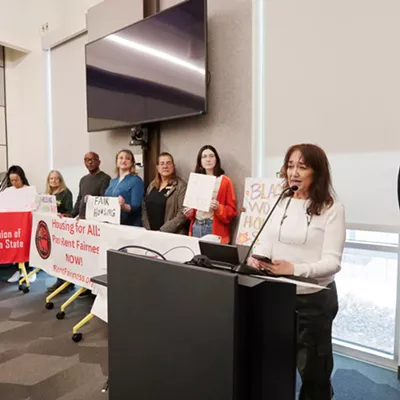Motivational posters adorn the classroom at Spokane’s WorkSource office. One, showing a tree growing atop a massive rock, is emblazoned with the word “Achievement”; another, labeled “Change,” depicts an ocean wave rolling ashore.
It’s mid-January, and a handful of well-dressed recruiters offer stale jokes, resume tips and details on open jobs call center positions, a machine operator, 25 part-time softball umpires. Facing the recruiters are about two-dozen job seekers at a “Speak With Employers” event. After hearing the list of positions, a hulking stone-faced man in a black leather jacket gets up and leaves.
The recruiters are here today to give advice from the perspective of companies who do the hiring. An early question comes from a neatly dressed man in the back row. He speaks in a soft Southern drawl. His name is Glenn Colvin. He’s retired from the Navy and looking for work. Colvin, 42, says he often hears about efforts to hire unemployed veterans, but every time he visits a company’s website, he sees equal-opportunity disclaimers saying veterans don’t get special consideration.
“I guess my question is: Does being a veteran count?” he asks. “I don’t know. I’ve not worked in the civilian world in a very long time.”
Colvin is one of many in the region who had, until recently, led a largely middle-class life: job security, decent income, health benefits, work that they enjoyed. But as the middle class faces stiff headwinds, Colvin and about 20,000 others in Spokane County must scrap for a living as the country hobbles out of the greatest downturn since the Great Depression. These jobseekers — part of America’s middle class — must also contend with the Inland Northwest’s shift to a more diversified economy that demands specialized education and skills. And they must make these transitions in an era of stagnant wages and rising education and health costs.
The recruiters try to answer Colvin’s question with common-sense aplomb.
“Sometimes it’s difficult to translate your skills and experiences into English,” a recruiter tells Colvin.
“I’m an I.T.,” he says, referring to his computer and Internet training.
“It may be more on how to best showcase your skills,” the recruiter says.
Jeff Toney, career services director at ITT Technical Institute in Spokane, sits up front. Toney is here not because his school is hiring but to facilitate the session. Toney gives Colvin an example of a company that was specifically looking for veterans, then offers his prognosis of the labor market.
“Recruiting has become very, very specific, whereas at one time, you could have general job duties and say, ‘Well, I’m kind of opening for anything,’” Toney says. “Right now, the ‘anything’ jobs aren’t open very often. It’s that very specific job that’s open.”
Specialized jobs requiring specific skills and specific people. It’s a challenge Spokane and much of the nation faces. A couple decades ago, a laid-off worker could hop to a different job in his or her industry or to a different field without needing a college degree or technical certificate. As skills become paramount, workers must now evolve and retrain.
Some at WorkSource — a branch of the state Employment Security Department that helps the unemployed find work — are upbeat about the region’s economy. In job data, they see growth in health care services and advanced manufacturing that pay close to or above the region’s average wage. But the difficulty is finding workers with those particular skills. If they can’t find enough qualified people, Work- Source employees try to convince employers to take a chance on workers with fewer skills.
It’s a negotiation process, requiring optimism and finesse. It’s a challenge John Dickson relishes.
Dickson, himself a former Boeing engineer, talks with a smile that rarely fades. Since becoming the Spokane WorkSource director, in July 2010, Dickson has tried to get people to realize their own skills while bringing workers and employers together. In certain ways, he serves as midwife to the region’s staggering economy.
When a laid-off construction worker walks into WorkSource, Dickson sees the possibilities. That person isn’t just a hammer-swinger but someone who assembles things — someone Dickson sees fitting in at an advanced manufacturing plant fabricating aluminum products. Then Dickson tries to assess exactly what an employer wants.
“Do you really need five years of aluminum-assembly experience? Or could we work with you?” says Dickson, paraphrasing his pitch to a hypothetical manufacturer. “[WorkSource has] some monies, we can do an on-the-job training where we take that construction worker who now has expressed a real interest in a yearround full-time job. Would you take a person with less experience if we got somebody to help train him or her?” Sometimes Dickson’s matchmaking works, helping both the worker and the employer see how they could work together.
A Slippery Definition
Who is middle class? “My sense is that the whole notion of the middle class has sort of taken on mythical proportions,” says Doug Hall, of the Economic Policy Institute in Washington, D.C. “We know a huge majority of Americans would self-identify as the middle class. It’s almost one of those ‘beauty is in the eye of the beholder’ sort of things.”
The idea of the middle class grew out of World War II, according to Hall. Think of the country as a five-story building. Each floor is 20 percent of the population. Strictly speaking, the middle class would constitute that center floor, with two others below and two on top. For an individual in Spokane in 2010, being on that middle floor meant earning an average of $42,200 in a year, according to the most recent regional economic forecast from Eastern Washington University.
But Hall suspects most Americans consider the idea of being in the middle class more broadly — they think of it as being somewhere on the middle three floors, representing 60 percent of all income earners. In 2010, a person earning an average of $31,800 would stand on that second floor. A person earning an average of $55,400 would stand on the fourth floor.
Hall ticks off the changes in recent decades that have besieged America’s middle class: stagnant or dropping wages, increasing health care and education costs, the decline of unions, cuts to universities and need-based student financial aid.
He says there are government policies that could help reverse that economic slide: investing in apprenticeship and job training programs, cultivating more next-generation manufacturing jobs, and pressuring China to adjust its currency to make trade more fair. Investing rather than cutting the country’s education system is also necessary, Hall says.
“There’s a lot of penny-wise and pound-foolish thinking out there,” he says. “The challenge we face is figuring out how to do that in a way that can provide solid wages for families . . . being respectful of the environment and [with] solid labor standards.”
In the meantime, realizing the American dream will be painful for many.
“I think that families right now would properly feel like they are vulnerable to the whims of the economy in a way that they haven’t [been] in the past,” Hall says. “In general, middle America is probably holding their own or losing their ground.”
The Search for Skills
The education needed in Spokane, according to Dickson, at Work- Source, is not necessarily four-year degrees but associate degrees and technical certificates.
But it’s hard for workers to spend money improving their skills. While WorkSource can give classes and occasionally help with training, people in Spokane County have the same purchasing power they had in 1996, according to Grant Forsyth, an Eastern economics professor. In order to get back to work, many people who lost their jobs in the current downturn have taken new ones that pay between 10 and 20 percent less, Forsyth says. Combine fewer paychecks with the rising cost of education, and workers — especially unemployed ones — will struggle to upgrade their skills.
“If you borrow [money for college], you run the risk of maybe not getting the job you thought you’d get and then you have to repay the loan,” says Forsyth, who also wrote the 2012 regional economic forecast.
He points to a broader national trend that bodes poorly for the middle class. Most of the job growth, he says, has occurred in two areas: low-skill, low-wage jobs and high-skill, high-wage jobs.“I think it’s basically what the labor market looks like now,” he says. “The share of middle class jobs either hasn’t changed or [has] declined over the last 15 years, but the share of the other two has increased.”
During the first decade of the 21st century, those numbers in Spokane skewed alarmingly toward low-wage. Between 2000 and 2010, the largest share of Spokane-area job growth occurred in the 40 percent of jobs that paid the least. The 40 percent of highest-paying jobs decreased their overall share. The middle 20 percent — again, that middle floor — barely budged, increasing just two-tenths of a percent.
Tatsuko Go Hollo, a policy associate with Seattle’s Economic Opportunity Institute, says that quality-of-life improvements are not a given in the modern American economy.
“It’s no longer true that each generation is doing better than the previous generation,” says Go Hollo. “Education and health, even in just the last decade, those have really skyrocketed as part of people’s budgets.”
While Spokane recovered quickly from the recession in 2000, the region this time is being left behind Western Washington, which hosts booming aerospace and technology industries.
“Spokane is really lagging, even more behind the Puget Sound region,” she says.
Changing Times
Today’s economic doldrums represent a big shift from the periods of prosperity Spokane and North Idaho enjoyed on and off during much of the 20th century. The early days of mining and timber made this region a manufacturing and transportation hub. Into the 1970s, lumber and mineral extraction in the Inland Northwest still provided good paychecks to area families, according to Patrick Jones, a researcher at Eastern Washington University. But the deep recession of the early 1980s hobbled the region’s growth, Jones says, and more recently, America’s manufacturing sector has become more tech-savvy and less welcoming to the people it once employed.
“If you measure it on the output side, [manufacturing is] still a player, nationally,” Jones says. “The difference is that output is accomplished by far fewer workers than it was 20 years ago.”
A glance at Spokane’s employment reflects this. In October 2000, there were over 21,000 manufacturing jobs here, according to data provided by the Urban Institute in Washington, D.C. In the same month in 2011, there were about 15,500 manufacturing jobs — a 26 percent decline.
Job growth in 2012 for the metro area between Spokane and Kootenai counties may only keep up with the pace of population growth. The region is expected to add between 500 and 1,000 jobs next year, according to one estimate. Unemployment in Spokane County was 9 percent in December 2011. For that number to go down 1 percent, about 2,000 jobs need to be created, Dickson says.
Still, Dickson is optimistic about the nature of the jobs being created — those health care and advanced manufacturing positions, among others — which he predicts will pay between $16 and $27 per hour. He’s also optimistic that existing jobs will soon come open as baby boomers retire.
It’s hard, however, to measure other aspects of the job market. Dickson says WorkSource can’t track whether open positions are being filled by locals or by people moving into the region. And unemployment in the Spokane area typically spikes during downturns, partly because rural workers from places like Chewelah and Colville stream in looking for work, he says.
But as prospects improve in workers’ hometowns, they return there, Dickson says. That may bring down Spokane’s jobless rate and create less competition among jobseekers, but it doesn’t create jobs.
Advice: Keep Growing
During his 23 years at Boeing, Dickson helped build the Air Force’s F-22 Raptor fighter. A photo of his engineering team standing in front of one of the sleek jet sits on his desk. At Boeing, he learned about lean management — the idea of always finding ways to improve a company and its operations.
In a sense, WorkSource is trying to do the same thing with the people it sees. Some workers need to learn how to use computers. Others need to be taught how to write a cover letter and tweak a resume. Many need help selling themselves, and WorkSource teaches them to give a 60-second “commercial” highlighting their skills and experience. Some need guidance to get into college or technical programs to find new jobs.
Dickson talks about how advanced manufacturing companies, like the Spokane-area firms that provide parts to Boeing aircraft, must meet more and more exacting standards in order to supply aerospace-grade products.
“You’ve got to keep growing, got to keep expanding what you do,” Dickson says. “It gets more and more challenging.”
The same could be said for finding middle-class prosperity in the Inland Northwest.





















